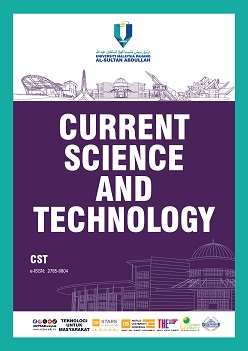The Effects of Indoor Air Quality on Health and Productivity of Workers in a Manufacturing Industry in Malaysia
DOI:
https://doi.org/10.15282/cst.v3i2.10391Keywords:
Indoor Air Quality, Health, ProductivityAbstract
Indoor Air Quality (IAQ) has a significant impact on health and quality of life in general. IAQ can be affected by various chemicals, including gases (i.e., carbon monoxide, ozone, radon), volatile organic compounds, particulate matter and fibres, organic and inorganic contaminants, and biological particles such as bacteria, fungi, and pollen. Studies of buildings have indicated that poor IAQ can cause health problems, affect occupants’ productivity. This research analyses how the indoor air quality can affect the health and productivity of workers in a manufacturing industry in Malaysia. As for the health effects, poor indoor air quality can give short-term effects as well as to a long-term risk. To complete this study, a set of questionnaires were distributed to 50 workers in the manufacturing industry in Malaysia. The findings indicated a modest positive correlation between IAQ and worker health, while significant correlation was observed between IAQ and productivity. In conclusion, there are many actions and recommendations that can be contemplated in protract the best and excellent reputation and performance of the company moreover by considering improving the indoor air quality, health and productivity of workers.
References
[1] M. Pimpong, “Work environmental factors and its impact on employee productivity: The mediating role of employee commitment,” E-Journal of Humanities, Arts and Social Sciences, vol. 4, no. 8, pp. 916–935, 2023.
[2] S. Singh and N. Chaudhary, “Employee productivity: An analysis of dimensions and methodology through systematic literature review,” Empirical Economics Letters, vol. 21, no. 4, pp. 183-204, 2022.
[3] J. Sauermann, “Performance measures and worker productivity,” IZA World of Labor, pp. 1-11, 2023.
[4] V. Kenny and Nnamdi S. O., “Employee productivity and organizational performance: A theoretical perspective,” Munich Personal RePEc Archive, no. 93294, pp. 1-10, 2019.
[5] A. F. Santos, P. D. Gaspar, A. Hamandosh, E. B. de Aguiar, A. C. G. Filho, and H. J. L. de Souza, “Best practices on HVAC design to minimize the risk of COVID-19 infection within indoor environments,” Brazilian Archives of Biology and Technology, vol. 63, pp. 1–11, 2020.
[6] S. Glen, “Cronbach’s Alpha: Definition, interpretation, SPSS: Elementary statistics for the rest of us!” StatisticsHowTo.com. [Online]. Available: https://www.statisticshowto.com/probability-and-statistics/statistics-definitions/cronbachs-alpha-spss/
[7] N. Goodman, N. Nematollahi, G. Agosti, and A. Steinemann, “Evaluating air quality with and without air fresheners,” Air Quality, Atmosphere & Health, vol. 13, no. 1, pp. 1–4, 2020.
[8] N. Aziz, M. A. Adman, N. S. Suhaimi, S. Misbari, A. R. Alias, A. Abd Aziz et al., “Indoor air quality (IAQ) and related risk factors for sick building syndrome (SBS) at the office and home: A systematic review,” in IOP Conference Series: Earth and Environmental Science, vol. 1140, no. 1, p. 012007, 2023.
[9] A. Demir, “Investigation of air quality in the underground and aboveground multi-storey car parks in terms of exhaust emissions,” Procedia-Social and Behavioral Sciences, vol. 195, no. 216, pp. 2601–2611, 2015.
[10] F. Ibrahim Alshaer, D. Fuad Albaharna, H. O. Ahmed, M. Ghiyath Anas, and J. Mohammed Aljassmi, “Qualitative analysis of air freshener spray,” Journal of Environmental and Public Health, vol. 2019, no. 1, p. 9316707, 2019.
[11] D. M. Zalk, S. Y. Paik, and P. Swuste, “Evaluating the control banding nanotool: A qualitative risk assessment method for controlling nanoparticle exposures,” Journal of Nanoparticle Research, vol. 11, no. 7, pp. 1685–1704, 2009.
Downloads
Published
Issue
Section
License
Copyright (c) 2023 The Author(s)

This work is licensed under a Creative Commons Attribution-NonCommercial 4.0 International License.



